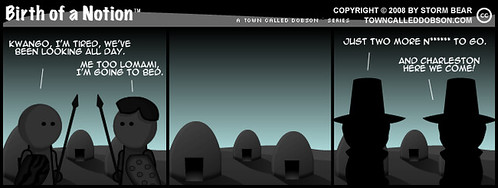Crossposted from Left Toon Lane, Bilerico Project & My Left Wing
The Atlantic slave trade would eventually be by far the largest and have the greatest impact. The first Europeans to arrive on the coast of Guinea were the Portuguese; the first European to actually buy African slaves in the region of Guinea was Antão Gonçalves, a Portuguese explorer. Originally interested in trading mainly for gold and spices, they set up colonies on the uninhabited islands of São Tomé. In the 16th century the Portuguese settlers found that these volcanic islands were ideal for growing sugar. Sugar growing is a labor-intensive undertaking and Portuguese settlers were difficult to attract due to the heat, lack of infrastructure, and hard life. To cultivate the sugar the Portuguese turned to large numbers of African slaves. Elmina Castle on the Gold Coast, originally built by African labor for the Portuguese in 1482 to control the gold trade, became an important depot for slaves that were to be transported to the New World.
The first Europeans to use African slaves in the New World were the Spaniards who sought auxiliaries for their conquest expeditions and laborers on islands such as Cuba and Hispaniola, where the alarming decline in the native population had spurred the first royal laws protecting the native population. The first African slaves arrived in Hispaniola in 1501.
In 1452, Pope Nicholas V issued the papal bull Dum Diversas, granting Afonso V of Portugal the right to reduce any “Saracens, pagans and any other unbelievers” to hereditary slavery. This approval of slavery was reaffirmed and extended in his Romanus Pontifex bull of 1455. These papal bulls came to serve as a justification for the subsequent era of slave trade and European colonialism. The followers of the church of England and Protestants did not use the papal bull as a justification.
Increasing penetration into the Americas by the Portuguese created more demand for labor in Brazil–primarily for farming and mining. Slave-based economies quickly spread to the Caribbean and the southern portion of what is today the United States. These areas all developed an insatiable demand for slaves. As European nations grew more powerful, especially Portugal, Spain, France and England, they began vying for control of the African slave trade, with little effect on the local African and Arab trading. Great Britain’s existing colonies in the Lesser Antilles and their effective naval control of the Mid Atlantic forced other countries to abandon their enterprises due to inefficiency in cost. The English crown provided a charter giving the Royal African Company monopoly over the African slave routes until 1712.
The Atlantic slave trade peaked in the late 18th century, when the largest number of slaves were captured on raiding expeditions into the interior of West Africa. These expeditions were typically carried out by African kingdoms, such as the Oyo empire (Yoruba), Kong Empire, Kingdom of Benin, Kingdom of Fouta Djallon, Kingdom of Fouta Tooro, Kingdom of Koya, Kingdom of Khasso, Kingdom of Kaabu, Fante Confederacy, Ashanti Confederacy, and the kingdom of Dahomey. Europeans rarely entered the interior of Africa, due to fear of disease and moreover fierce African resistance.
Before the arrival of the Portuguese, slavery had already existed in Kingdom of Kongo. Despite its establishment within his kingdom, Afonso I of Kongo believed that the slave trade should be subject to Kongo law. When he suspected the Portuguese of receiving illegally enslaved persons to sell, he wrote letters to the King João III of Portugal in 1526 imploring him to put a stop to the practice.
The kings of Dahomey sold their war captives into transatlantic slavery, who otherwise would have been killed in a ceremony known as the Annual Customs. As one of West Africa’s principal slave states, Dahomey became extremely unpopular with neighboring peoples. Like the Bambara Empire to the east, the Khasso kingdoms depended heavily on the slave trade for their economy. A family’s status was indicated by the number of slaves it owned, leading to wars for the sole purpose of taking more captives. This trade led the Khasso into increasing contact with the European settlements of Africa’s west coast, particularly the French. Benin grew increasingly rich during the 16th and 17th centuries on the slave trade with Europe; slaves from enemy states of the interior were sold, and carried to the Americas in Dutch and Portuguese ships. The Bight of Benin’s shore soon came to be known as the “Slave Coast”.
Disclaimer:
When I went to school, we were never taught Black History. We never learned about the Black leaders, the long, agonizing history that brought most Blacks to America. Those atrocities were glossed over in favor of mindlessly boring topics like the X Y Z Affair.
This series of cartoons will review Black history as told from a Black mother to an interracial child. This series will be ugly, course, horrific and truthful. I will mostly abandon the commentary for an article on Black history.
This series is not about Obama or Hillary. I want to you to try to imagine how Black families tell their children of the atrocities their ancestors, all of them, suffered because of the color of their skin. Try to imagine how Black families counsel their children when someone calls them “nigger” for the first time. Can you imagine the bone crushing emotion that must well up? Can you imagine the agony, frustration and anger?
Can you imagine being the Black preacher who tries to paint a picture of a just God every Sunday? Especially in a country that claims where the notion of racism is a thing of the past, the job is difficult.
These strips may at times be entertaining and sometimes they may not.
I don’t want you to laugh so hard you cry, I want you to cry so hard you do something about it.





